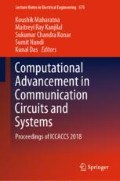Abstract
Listening to music has been reported to provide health benefits. This has inspired the researchers to recognize the effect of music on various organs like the heart. In the past few decades, analysis of the electrocardiogram (ECG) signals has been widely used to divulge information about the cardiac activity not only for the diagnosis of the cardiovascular diseases but also during the exposure to a stimulus like music. This study attempts to identify the occurrence of any change in the cardiac activity due to the exposure to a motivational song. The ECG signals were acquired before and after exposing 18 volunteers to the motivational song. The recurrence plot analysis and recurrence quantification analysis (RQA) of the ECG signals were performed. The statistical analysis of the RQA features suggested a variation in the cardiac activity, which was further evinced by the classification of the RQA features using the artificial neural network (ANN) with an accuracy of >85%.
Access this chapter
Tax calculation will be finalised at checkout
Purchases are for personal use only
References
Y.Z. Tan et al., The effect of relaxing music on heart rate and heart rate variability during ECG GATED-myocardial perfusion scintigraphy. Complement. Ther. Clin. Pract. 21, 137–140 (2015)
C.-H. Ko et al., Effect of music on level of anxiety in patients undergoing colonoscopy without sedation. J. Chin. Med. Assoc. 80, 154–160 (2017)
L.J. Labrague, D.M. McEnroe-Petitte, Influence of music on preoperative anxiety and physiologic parameters in women undergoing gynecologic surgery. Clin. Nurs. Res. 25, 157–173 (2016)
D. Elliott et al., The effect of motivational music on sub-maximal exercise. Eur. J. Sport Sci. 5, 97–106 (2005)
L.O. Bonde, T. Theorell, Music and Public Health: A Nordic Perspective (Springer, 2018)
L.O. Bonde et al., in 10th European Music Therapy Conference. Music and Public Health: Music in the Everyday Life of Adult Danes and Its Relationship with Health (2016)
S.K. Nayak et al., in Pattern and Data Analysis in Healthcare Settings, ed. by IGI Global. Effect of Odia and Tamil Music on the ANS and the Conduction Pathway of Heart of Odia Volunteers (2017), pp. 240–263
S.-T. Chen et al., in Advanced Materials Research. Recurrence plot analysis of HRV for exposure to low-frequency noise (2014)
S. K. Nayak et al., A review on the nonlinear dynamical system analysis of electrocardiogram signal. J. Healthc. Eng. 2018 (2018)
N. Marwan et al., Recurrence-plot-based measures of complexity and their application to heart-rate-variability data. Phys. Rev. E 66, 026702 (2002)
H. Ferdinando et al., Violence detection from ECG signals: a preliminary study. J. Pattern Recogn. Res. 1, 7–18 (2017)
U.R. Acharya et al., in 2015 IEEE International Conference on Systems, Man, and Cybernetics (SMC). Automated Prediction of Sudden Cardiac Death Risk Using Kolmogorov Complexity and Recurrence Quantification Analysis Features Extracted from HRV Signals (2015), pp. 1110–1115
U. Desai et al., Diagnosis of multiclass tachycardia beats using recurrence quantification analysis and ensemble classifiers. J. Mech. Med. Biol. 16, 1640005 (2016)
L. Billeci et al., Patient-specific seizure prediction based on heart rate variability and recurrence quantification analysis. PLoS ONE 13, e0204339 (2018)
J.P. Eckmann, Recurrence plots of dynamical systems. Europhys. Lett. 5, 973–977 (1987)
H. Yang, Multiscale recurrence quantification analysis of spatial cardiac vectorcardiogram signals. IEEE Trans. Biomed. Eng. 58, 339–347 (2011)
Y. Chen, H. Yang, Multiscale recurrence analysis of long-term nonlinear and nonstationary time series. Chaos Solitons Fractals 45, 978–987 (2012)
H. Hsu, P.A. Lachenbruch, Paired t Test (Wiley StatsRef: Statistics Reference Online, 2014)
L. Breiman, Classification and Regression Trees (Routledge, 2017)
C.C. Hau, Handbook of Pattern Recognition and Computer Vision (World Scientific, 2015)
S.K. Nayak et al., in Advancements of Medical Electronics. Automated Neural Network Based Classification of HRV and ECG Signals of Smokers: A Preliminary Study (Springer, 2015), pp. 271–279
Author information
Authors and Affiliations
Corresponding author
Editor information
Editors and Affiliations
Rights and permissions
Copyright information
© 2020 Springer Nature Singapore Pte Ltd.
About this paper
Cite this paper
Paul, S., Yadu, G., Nayak, S.K., Dey, A., Pal, K. (2020). Recurrence Quantification Analysis of Electrocardiogram Signals to Recognize the Effect of a Motivational Song on the Cardiac Electrophysiology. In: Maharatna, K., Kanjilal, M., Konar, S., Nandi, S., Das, K. (eds) Computational Advancement in Communication Circuits and Systems. Lecture Notes in Electrical Engineering, vol 575. Springer, Singapore. https://doi.org/10.1007/978-981-13-8687-9_16
Download citation
DOI: https://doi.org/10.1007/978-981-13-8687-9_16
Published:
Publisher Name: Springer, Singapore
Print ISBN: 978-981-13-8686-2
Online ISBN: 978-981-13-8687-9
eBook Packages: EngineeringEngineering (R0)

